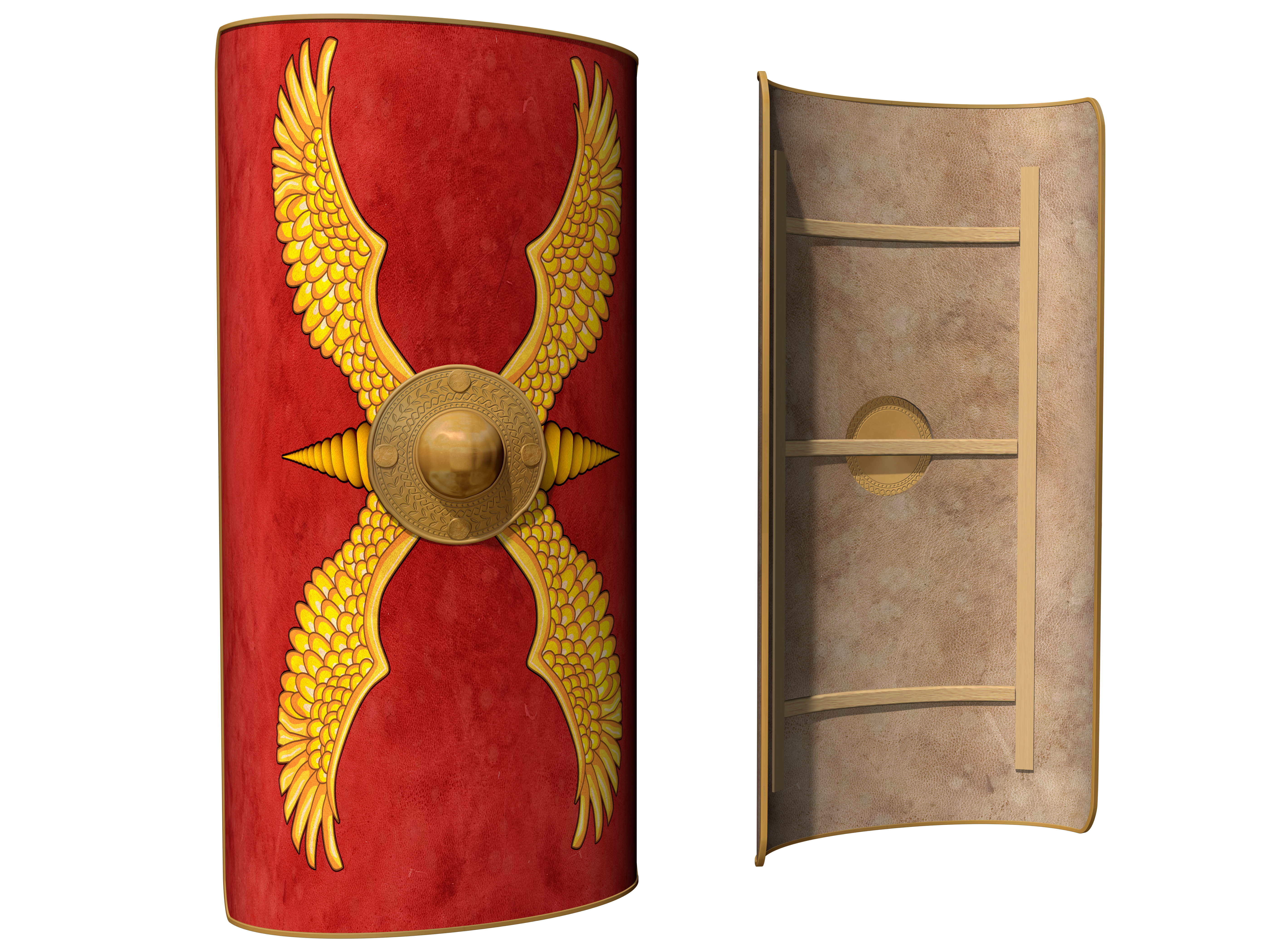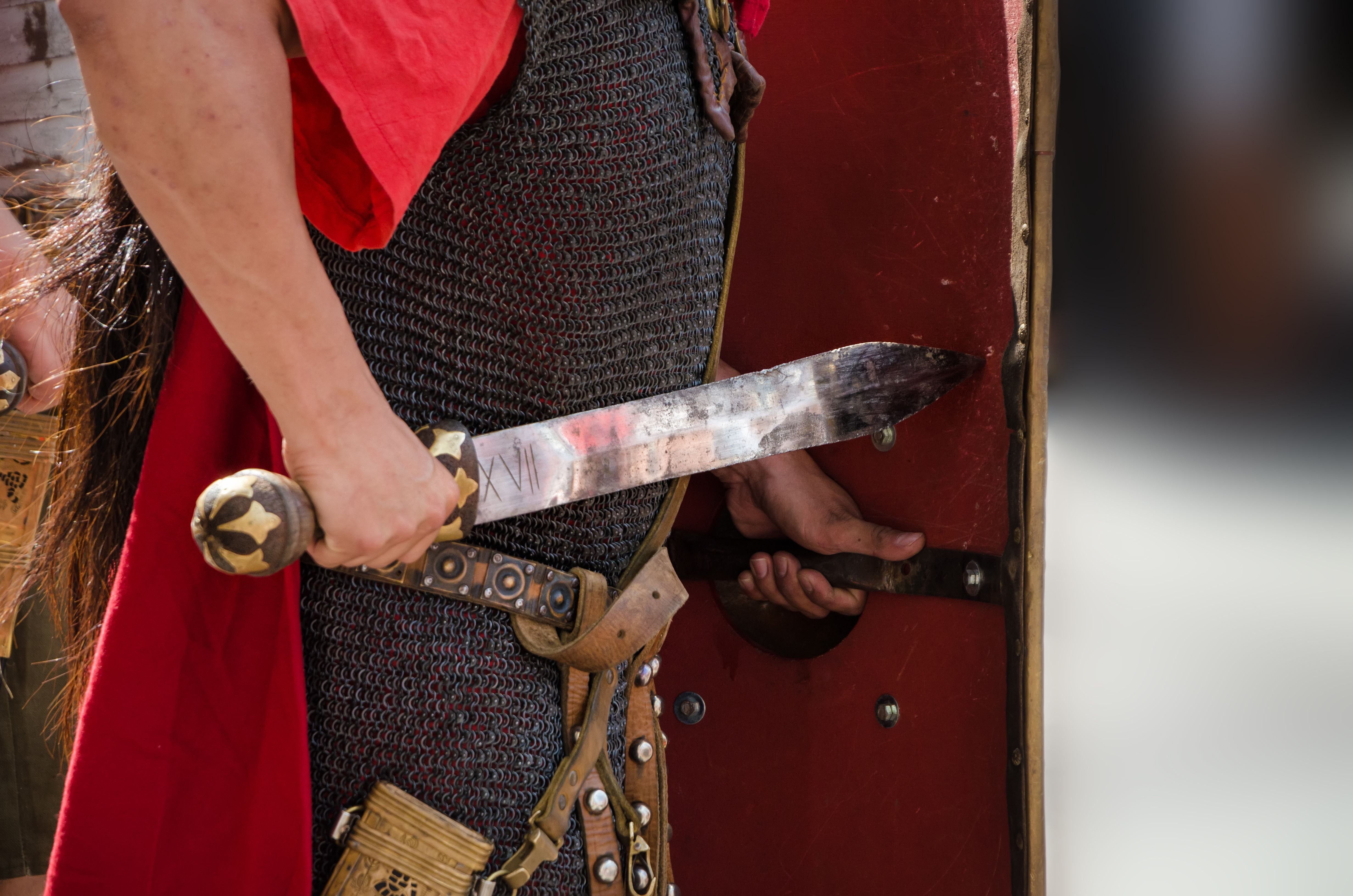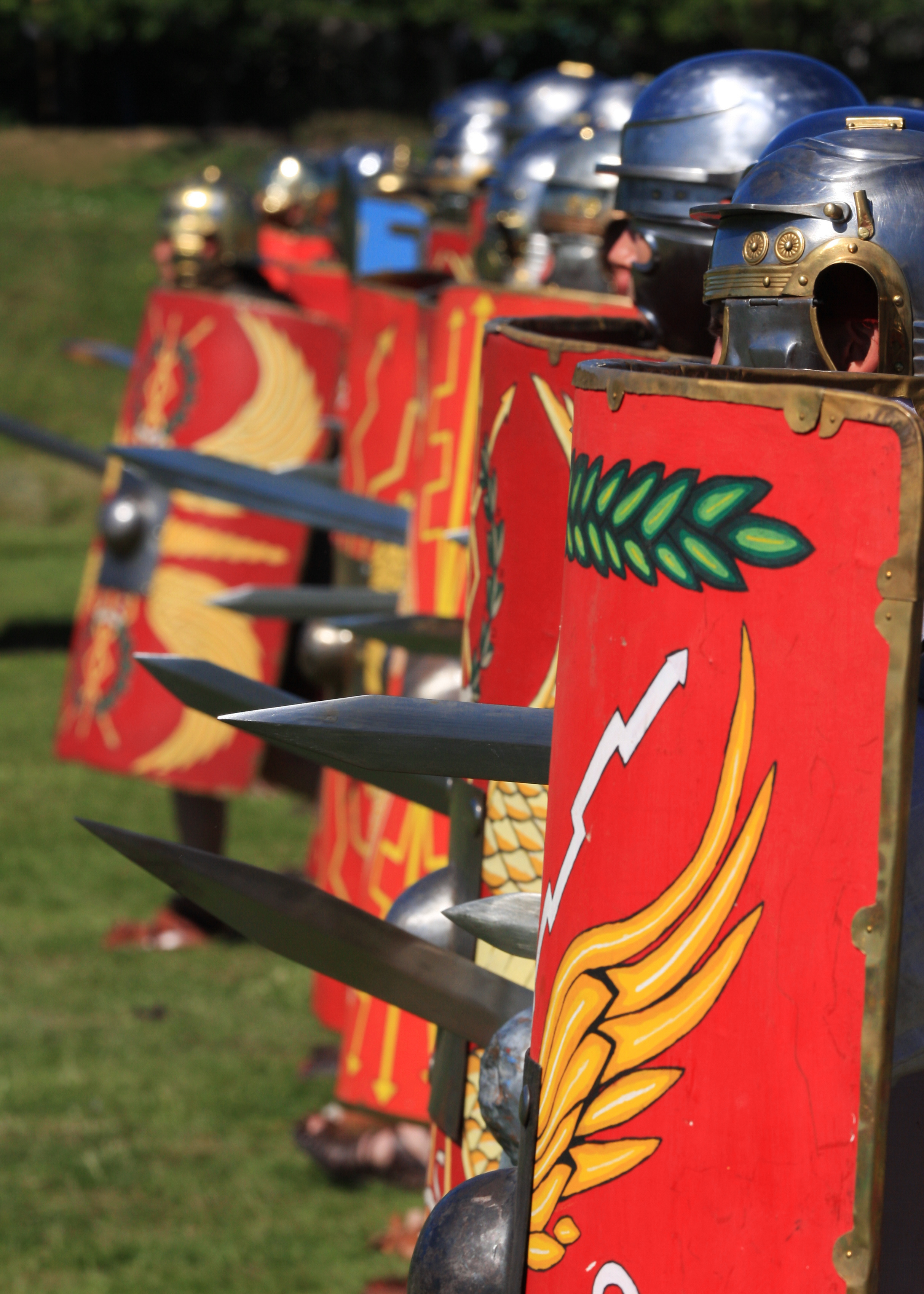
Adrian Goldsworthy provides a good description of a Roman shield, called a scutum, in his book The Complete Roman Army on page 129. A well-preserved shield was found at Dura Europus that dates from the 3rd century.
The shield is 3’ 3” tall by 2’ 8” wide in a curved shape.
It is two inches thick, consisting of three layers of wood glued together.
Note: A number of additional comments have been added since this article was initially posted. Additions will not all be identified as such. Any corrections will be clearly labeled.

The center layer is vertical and the two outside layers are horizontal. On the inside there are strips of wood attached vertically for extra strength. There is a thin layer of leather on the front and back. There was probably a layer of cotton underneath the leather. The edge has a wide leather (or metal) binding and there are leather reinforcements on the corners.
There is an opening in the center of the shield for a boss (a hand grip), but one was apparently not attached to the recovered example. Instead there is a horizontal handgrip. I’m guessing that means there was a bar across the shield.
The boss in the center strengthened the shield and made it easier to handle. That is according to several sources I read.
One commenter said a scutum would be more flexible on the edges and more rigid in the center. This would contribute to fighting ability of the soldier.

A reconstruction of this shield with a boss weighed in at 12 pounds.
The leather covering and wood core would have provided great protection against arrows, including flaming arrows. (This is the beauty of the tie in to Ephesians chapter 6.) Many comments I’ve read suggest the scutum would be soaked in water before a battle, providing even better protection from flaming arrows.
Archers assembled behind the battle line would fire a massive volley of arrows over the heads of their line of soldiers on the attack well before the two lines met. Goal of launching that flock of arrows was to hurt many enemy soldiers, take them out of the battle, and disorganize the entire formation.
Author Michael Lantz, in Suit Up!: Putting on the Full Armor of God, provides a description of the flaming arrow concept back in biblical times.
He said strips of cloth would be dipped in pitch, or tar. The cloth would be wrapped around the tip of an arrow. Just before launching the arrow, the pitch would be set on fire.
Author says the burning pitch would splatter when it hit something, spreading around the burning pitch. Anything flammable would ignite.
During a battle, he suggests shields would have so many smoking arrows sticking out of them that the shields looked somewhat like a “roasted porcupine.”

Seems like 2 inches of laminated wood covered in leather would have done a good job protecting from spears. Of course, if the spear penetrated you would likely have to drop the shield. If the spear stuck you would have to take precious seconds knocking it loose. The extra weight and clumsiness of a spear sticking out of the scutum would have been too much to deal with moments before contact with the enemy.
Wikipedia reports Roman soldiers carried an oval shield, called a clipeus, until sometime in the 4th century BC. The clipeus was similar to what the Greek hoplites carried. By the start of the 4th century an oval shield was in use.
Article says a scutum weighed in at 22 pounds.

Wikipedia quotes Polybius as saying the scutum measured 2 1/2 feet wide and 4 feet tall, with iron reinforcement on the top and bottom edges.
The Roman soldiers each carried a pilum, or spear, which was thrown en-mass immediately before the final advance on foot. If the pilum got a good hit on a shield, the bearer would have to drop the shield, losing most of his protection moments before the Romans arrived. With a sharp point and plenty of weight behind it, a spear would have plenty of penetrating power. A solid hit might go all the way through the shield and get a disabling hit on the soldier.
Even if not injured, a soldier with a spear stuck in his shield might not have the seconds needed to get rid of the spear and thus have to drop the shield since battle was seconds away.
On a day-to-day basis, a scutum would be carried in a leather bag to provide protection to the shield.

As an aside, historians are pleased that archaeologists found an intact scutum. Something made of wood and leather over a thousand years ago should have long since decomposed. That shows the severe limits on the knowledge of ancient times. Much of ‘our’ knowledge is based a few scraps of artifacts here, along with one or two documents there.
A re-enactor group in the Washington D.C. area, Legio XX, The Imperial Roman Twentieth Legion, has a handbook on creating items in a legionairre’s kit. They have a fun page describing how to construct a realistic Roman scutum.
For historical evidence supporting their description, they cite Polybius’ description in second century BC, two shields (1st century BC and 1st century AD), and two scutums (both frm Dura Europas and around 250 AD), one boss, and a number of fragments. That’s it. They cite two shields and two scuta.
I infer from their citations, and their apparent yearning for as much historical accuracy as possible, that those four recovered examples might just about be the limit of known, recovered Roman shields.

I will quote under fair use their description of what appears to be the best find, which is mentioned at the top of this post:
Dura Europas Scutum, c. 250 AD: Curved rectangle c. 41″x 33″, quite deep, with square corners. Three layers of wood strips totalling 1/4″ thick overall. Wood back bracing, “half-round”, middle horizontal brace thickened to form grip. Front and back covered with thin leather, and front has additional layer of fabric between leather and wood. Leather or hide rim stitched on. Whole shield painted red, and front heavily decorated with intricate painted designs and figures. Boss missing, but had rectangular base. Total weight c. 12 pounds.
Other posts on weaponry of a Roman Legionnaire:
- Introduction
- Scutum – shield
- Gladius – sword
- Caligae – sandals
- Armor – Breastplate
- Galea – helmet
- Pilum – javelin
Upcoming posts:
- Cloak